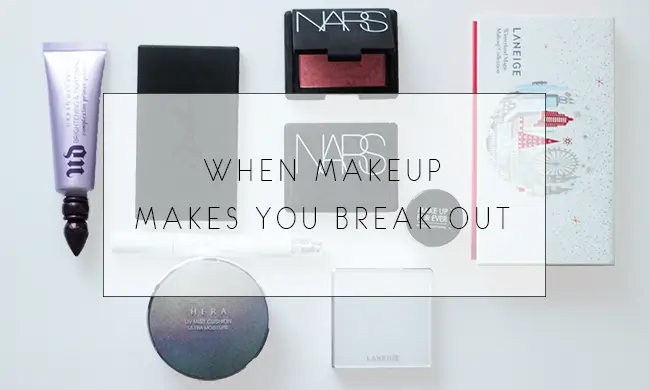Remember that day when you finally purchased the foundation or blush you had wanted for weeks? Remember how this foundation made you look amazing and how you wanted to tell the whole world about it? Remember how, after a few days, you finally noticed those small white bumps or zits on your face, and you started crying in despair, hoping to find another culprit than the foundation itself?
Well, I remember it. It happened to me not long ago with the Nars Orgasm Blush. I was so excited to finally purchase it after so many months of anxiety the mere thought of breaking out because of it never even crossed my mind for a second.
I’m a curious girl, so whenever makeup or a skincare product makes me break out or causes other skincare troubles, I must find out why.
I have sensitive, dry skin, and things I have to rub on my face, like cotton pads, towels, or brushes, are my worst enemies. My moisture level drops dramatically throughout the day even with rich moisturizers, and since powders absorb moisture and make your dry even drier, using a powder blush was the problem itself: my skin lacked moisture because of it, and desperately tried to make me understand by throwing a massive tantrum, resulting in those tiny white bumps. I quickly fixed the problem by mixing the blush with a drop of oil or a bit of moisturizer to make it a cream blush, but I also noticed some makeup brushes irritating my skin.
This little adventure with the Nars blush reminded me of those fine lines and tiny white bumps (milia) that mysteriously appear under my eyes whenever I wear thick-type concealers or use too much moisturizer under my eyes. Most concealers are too thick and too drying for me. Thus, they visibly empathize with my fine lines. Just like with the blush, I quickly fixed the problem by using a liquid-type concealer (EROMEY), and whenever I want to use a thicker one, like the Nars Creamy Radiant Concealer, I mix it with a tiny bit of moisturizer.
1- Find the culprit
It could be your foundation, blush, or any other makeup product you usually wear. Apply the cosmetic you suspect on your skin without anything else, and check if small bumps or zits appear.
2- Tools matter
The problem could also come from the tools you use to apply your makeup, like a brush or fingers. The only tools my skin likes are sponges, like the Beauty Blender. Whenever I try to use my makeup with a brush or my fingers, my skin becomes extremely dry after a few hours, resulting in tiny bumps or irritated skin. I recently got my hands on the Etude House Play 101 Stick in the shade Rose Gold (a beautiful pink highlighter), and whenever I rub it directly on my cheeks, I end up with small bumps, but if I rub the stick directly on my fingers and dab them on my skin, everything is fine.
3- Formula & Texture
Some ingredients can be irritating and clog pores, resulting in breakouts and various skincare troubles. Thus, you always need to check the ingredient list before purchasing a skincare or cosmetic product.
Silicone, for example, has been a controversial ingredient for years. They are present in most of our skincare and cosmetics, and some skin (usually acne-prone and oily) dislike them as they can clog pores. To avoid future bad purchases, you must identify the ingredients your skin likes and hates the most. To do so, compare the ingredients in your products. For example, if a foundation makes you break out, check out the ingredient list and compare it with another foundation your skin likes. In my case, the culprit in the Nars Orgasm is Talc. I slightly suspected beeswax, but considering my favorite CC Cream by Hera contains beeswax, I quickly let go of my suspicions.
The texture also matters. People with dry skin usually prefer liquid-type foundations, while those with oily skin usually go for powder-type. Once again, the most important thing is the ingredient list: You can find many oil-free (non-comedogenic) liquid foundations on the market, perfect for oily skin. The other way around doesn’t work very well, as most people with dry skin should avoid powder-type cosmetics.
4- Too drying or too oily
If your cosmetics make your skin too dry, you can try mixing them with a moisturizing product like a serum, an emulsion, a moisturizing cream, or an oil. I like to mix my powder blushes (like the Nars Orgasm I mentioned above) with my Hera Aquabolic Moisturizing Emulsion or a drop of my Innisfree Canola Honey Oil.
You can also use a moisturizing mist, like the Tatcha Dewy Skin Mist, to moisturize and hydrate your skin throughout the day.
If you have dry skin, try looking for non-oil-free moisturizing formulas, and if you have oily skin, go for water-based and oil-free formulas.
5- Skincare & Primer
Sometimes, cosmetics and skin care products don’t go well together. I know for a fact that using too many moisturizing products without leaving your skin the time to absorb them can lead to breakouts, flakes, and more. One of my golden rules is to always apply my makeup 10 minutes after applying my skincare products.
I also noticed a huge difference in the lasting power and finish of my makeup whenever I use a water-based foundation (oil-free) on top of an oil-based moisturizer. Oil and water don’t mix together, so whenever you use an oil-based moisturizer, you should also use an oil-based primer or foundation. Your primer should also always be the same formula as your foundation.
I recently purchased the fabulous multi-purpose primer Lovely Cream by Cosrx. Even though I like it a lot, I noticed my skin becomes extremely greasy and somehow oily if I apply it less than 10 minutes after my skincare products—unless I mix it directly with my moisturizer—and if I use my fingers to blend it instead of a sponge.
6- Exfoliation
This is one of my favorite topics. You should never exfoliate your skin daily—otherwise, your skin will make you pay a great deal for it—but getting rid of those dead skin cells may change the way your foundation looks.
Exfoliation often answers flaky skin and dry patches as it removes dead skin cells. If your foundation looks cakey, flaky, or weird, try to exfoliate it. While I am not a fan of scrubs (the ones with beads), I find peeling gels like the Mamonde Natural Peeling Gel or the Iaso Triple White Peeling Gel extremely gentle, as they can be used twice a week. If you find peeling gels too gentle, try a chemical exfoliator, like the Paula Choice 10% AHA Weekly Treatment or the Mizon 8% AHA Serum.

